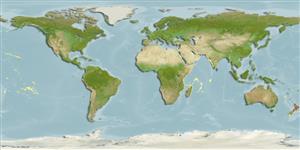Common names from other countries
Classification / Names / Names
Nomi Comuni | Sinonimi | Catalog of Fishes (gen., sp.) | ITIS | CoL | WoRMS
Environment: milieu / climate zone / depth range / distribution range
Ecologia
. Subtropical
Indo-Pacific.
Length at first maturity / Size / Peso / Age
Maturity: Lm ? range ? - ? cmEtà massima riportata: 6 anni (Ref. 8702)
Found in intertidal reefs and boulders (Ref. 337). Abundantly living on rocks between tide-marks, most frequent at half-tide mark or higher (Ref. 88739). Members of the family Neritidae are herbivorous, grazing by night at low tide on fine algae and detritus covering the bottoms where they live (Ref. 349).
Life cycle and mating behavior
Maturità | Riproduzione | Deposizione | Uova | Fecundity | Larve
Members of the order Neritopsina are mostly gonochoric and broadcast spawners. Life cycle: Embryos develop into planktonic trocophore larvae and later into juvenile veligers before becoming fully grown adults.
Brook, F.J. 1998. (Ref. 337)
IUCN Red List Status (Ref. 130435)
CITES status (Ref. 108899)
Not Evaluated
Not Evaluated
Threat to humans
Harmless
Human uses
| FishSource |
Strumenti
Fonti Internet
Estimates based on models
Preferred temperature
(Ref.
115969): 15.9 - 28.2, mean 23.2 (based on 210 cells).
